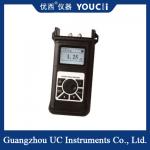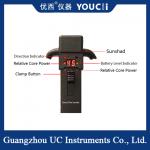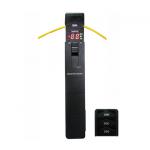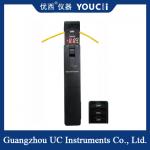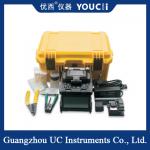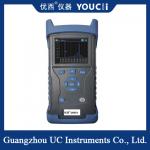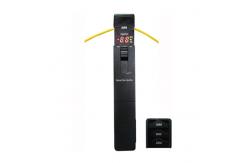Handheld Optical Fiber Identifier Maintaining Optical Fiber
Networks
Handheld optical fiber detectors are essential tools for
maintaining optical fiber networks. Their core function is to
identify optical signals in optical fibers through non-intrusive
detection technology without interrupting services. Specific
functions include: Optical signal detection: Determine whether there is optical signal
transmission in the optical fiber and identify the optical fiber in
use.
Optical power measurement: Displays the optical power value (e.g.,
-16 DBM) to assist in evaluating signal strength.
Direction indication: Display the direction of light signal
transmission (such as from left to right or from right to left)
through arrows or LED lights.
Modulation signal recognition: Detect modulation signals of
specific frequencies and distinguish service signals from test
signals.
Specifications
Model# | U8652 | Identified Wavelength Range | 800-1700 nm | Identified Signal Type | CW, 270Hz±5%,1kHz±5%,2kHz±5% | Detector Type | Ø1mm InGaAs 2pcs | Adapter Type | Ø0.25 , Ø0.9, Ø2.0, Ø3.0 | Signal Direction | Left & Right LED | Singe Direction Test Range (dBm, CW/0.9mm bare fiber) | -46~10(1310nm) | -50~10(1550nm) | Signal Power Test Range (dBm, CW/0.9mm bare fiber) | -50~+10 | Signal Frequency Display (Hz) | 270, 1k, 2k | Frequency Test Range (dBm, Average Value) | Ø0.9, Ø2.0, Ø3.0
-30~0 (270Hz,1KHz) | Ø0.9, Ø2.0, Ø3.0
-25~0 (2KHz) | Ø0.25
-25~0 (1KHz,2KHz) | Ø0.25
-20~0 (2KHz) | Insertion Loss(dB, Typical Value) | 0.8 (1310nm) | 2.5 (1550nm) | Alkaline Battery(V) | 2pcs AAA batteries | Operating Temperature(℃) | -10-+60 | Storage Temperature(℃) | -25-+70 | Dimension (mm) | 196X30.5X27 | Weight (g) | 250 |
Application scenarios
Optical fiber installation and maintenance
When splicing, cutting or wiring optical fibers, quickly identify
the target optical fiber to avoid misoperation.
Check the connectivity of the optical fiber patch cord or pigtail
to ensure the normal operation of the link.
Optical cable splicing and emergency repair
In the process of optical cable relocation or fault repair,
accurately identify the optical fibers in use to prevent accidental
interruption of services.
Through modulation signal detection, the test signal is
distinguished from the real service signal.
|
